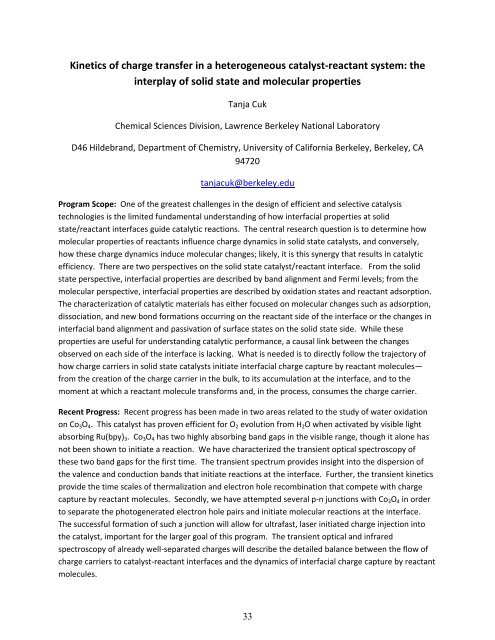Eighth Condensed Phase and Interfacial Molecular Science (CPIMS)
Eighth Condensed Phase and Interfacial Molecular Science (CPIMS)
Eighth Condensed Phase and Interfacial Molecular Science (CPIMS)
You also want an ePaper? Increase the reach of your titles
YUMPU automatically turns print PDFs into web optimized ePapers that Google loves.
Kinetics of charge transfer in a heterogeneous catalyst‐reactant system: the<br />
interplay of solid state <strong>and</strong> molecular properties<br />
Tanja Cuk<br />
Chemical <strong>Science</strong>s Division, Lawrence Berkeley National Laboratory<br />
D46 Hildebr<strong>and</strong>, Department of Chemistry, University of California Berkeley, Berkeley, CA<br />
94720<br />
tanjacuk@berkeley.edu<br />
Program Scope: One of the greatest challenges in the design of efficient <strong>and</strong> selective catalysis<br />
technologies is the limited fundamental underst<strong>and</strong>ing of how interfacial properties at solid<br />
state/reactant interfaces guide catalytic reactions. The central research question is to determine how<br />
molecular properties of reactants influence charge dynamics in solid state catalysts, <strong>and</strong> conversely,<br />
how these charge dynamics induce molecular changes; likely, it is this synergy that results in catalytic<br />
efficiency. There are two perspectives on the solid state catalyst/reactant interface. From the solid<br />
state perspective, interfacial properties are described by b<strong>and</strong> alignment <strong>and</strong> Fermi levels; from the<br />
molecular perspective, interfacial properties are described by oxidation states <strong>and</strong> reactant adsorption.<br />
The characterization of catalytic materials has either focused on molecular changes such as adsorption,<br />
dissociation, <strong>and</strong> new bond formations occurring on the reactant side of the interface or the changes in<br />
interfacial b<strong>and</strong> alignment <strong>and</strong> passivation of surface states on the solid state side. While these<br />
properties are useful for underst<strong>and</strong>ing catalytic performance, a causal link between the changes<br />
observed on each side of the interface is lacking. What is needed is to directly follow the trajectory of<br />
how charge carriers in solid state catalysts initiate interfacial charge capture by reactant molecules—<br />
from the creation of the charge carrier in the bulk, to its accumulation at the interface, <strong>and</strong> to the<br />
moment at which a reactant molecule transforms <strong>and</strong>, in the process, consumes the charge carrier.<br />
Recent Progress: Recent progress has been made in two areas related to the study of water oxidation<br />
on Co3O4. This catalyst has proven efficient for O2 evolution from H2O when activated by visible light<br />
absorbing Ru(bpy)3. Co3O4 has two highly absorbing b<strong>and</strong> gaps in the visible range, though it alone has<br />
not been shown to initiate a reaction. We have characterized the transient optical spectroscopy of<br />
these two b<strong>and</strong> gaps for the first time. The transient spectrum provides insight into the dispersion of<br />
the valence <strong>and</strong> conduction b<strong>and</strong>s that initiate reactions at the interface. Further, the transient kinetics<br />
provide the time scales of thermalization <strong>and</strong> electron hole recombination that compete with charge<br />
capture by reactant molecules. Secondly, we have attempted several p‐n junctions with Co3O4 in order<br />
to separate the photogenerated electron hole pairs <strong>and</strong> initiate molecular reactions at the interface.<br />
The successful formation of such a junction will allow for ultrafast, laser initiated charge injection into<br />
the catalyst, important for the larger goal of this program. The transient optical <strong>and</strong> infrared<br />
spectroscopy of already well‐separated charges will describe the detailed balance between the flow of<br />
charge carriers to catalyst‐reactant interfaces <strong>and</strong> the dynamics of interfacial charge capture by reactant<br />
molecules.<br />
33
















